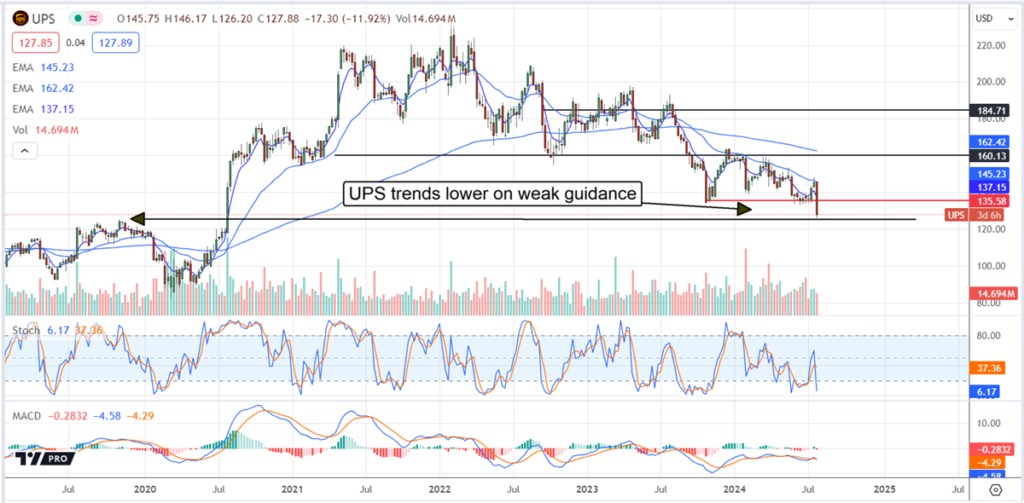- UPS experiences a quarter marked by reduced guidance, sparking concerns among investors.
- Labor costs are chipping away at profits, potentially leading to a downward revision of analyst estimates.
- While capital returns remain steady, a swift rebound for the stock is unlikely, and any revival may lack robustness.
The company made a slight turn in Q2, yet signs indicate that a prompt or vigorous recovery may not materialize any time soon.
For the first time in over two years, volume growth, albeit present, was lackluster and counterbalanced by other factors, hinting at an L-shaped recovery as the best-case scenario.
Characterized by a sharp downturn followed by a gradual and potentially protracted uptick, an L-shaped recovery could stretch over quarters, or even years.
Despite UPS’s fundamentally sound business trajectory and secure capital returns, growth prospects appear muted in the near term.
The Federal Reserve’s policy shifts and potential interest rate adjustments could serve as catalysts, though their effects might take months to trickle down to the consumer level, impacting UPS’s business.
UPS Stumbles on Earnings: Revised Guidance Dampens Sentiment
While UPS’s quarterly performance wasn’t abysmal, it failed to meet expectations, exacerbated by a trimmed guidance outlook. Net revenue at $21.8 billion dipped 1.4%, veering sharply from growth projections and falling 200 basis points below analyst consensus.
Volume expansion was confined to the U.S., overshadowed by pricing dynamics, mixed performance, and weakness in other segments. Domestic operations saw a 1.9% decline, while international operations saw a 1% drop on a 2% volume decrease. Notably, the Supply Chain Solutions segment displayed resilience, growing by 2.6%, buoyed by logistics and healthcare operations.
Margins, a pivotal concern, failed to exhibit the anticipated improvement in Q2. The non-execution stemmed from last year’s labor cost increases driven by the Teamster negotiations, leading to a 30% slide in operating profit and a 29% drop in adjusted operating profits. Adjusted EPS closed at $1.79, plummeting 30% year-over-year and lagging 1000 basis points behind expectations.
Market sentiment soured on the news, driving the stock down by over 10% and breaching crucial support levels, instigating a pronounced sell-off that might inflict further downward pressure on the transportation giant’s shares.
United Parcel Service Resumes Stock Buybacks: Limited Impact on Market Dynamics
United Parcel Service curtailed share repurchases in 2020 to fortify its financial position amidst economic uncertainties. The strategic pivot yielded desired results, prompting a resumption of buybacks in the current quarter.
The company aims to allocate $500 million toward buybacks this year and $1 billion annually, representing less than 0.5% of its market capitalization. Although a boon for investors, these buybacks are unlikely to substantially sway market dynamics.
Institutional activities and analyst assessments present additional challenges. Institutions, which were net buyers in Q1, transitioned to net sellers in Q2, a trend persisting into Q3. Analysts have been paring back their targets, potentially signaling a bearish market sentiment.
Currently straddling the ‘Reduce’ and ‘2024’ sentiment zones and with diminishing price targets, UPS may continue to face headwinds in the subsequent quarters, pressuring market conditions.
UPS Plunges Below Key Support Levels
Following its lackluster Q2 results, UPS shares plummeted over 10%, marking a new multi-year low. Investors might witness a consolidation phase at this new threshold before an anticipated downward move.
The $135 support level now poses a formidable resistance, suggesting a potential bottoming signal if breached. Conversely, if the price action falters around this mark, a decline towards $120 or lower could ensue.




